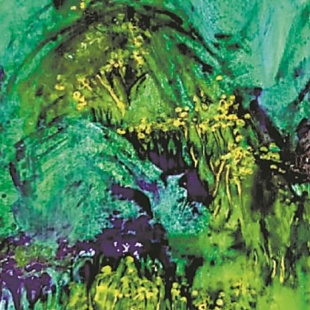Art scholar reimagines classics with brushstrokes


In a quiet gallery tucked along Broadway in Lower Manhattan, New York City, centuries whisper through pigment and mist.
In the exhibition titled Poetics of Chunyang: Transgression and Invocation of A Tradition, Chinese artist Li Chunyang, currently a visiting scholar at Harvard University, conjures the soul of classical poetry into contemporary form, with brush, ink and emotion.
On view through June at the 456 Gallery, the exhibition features nearly 30 recent works that reimagine Chinese literati traditions with a bold and lyrical visual language.
Best known for her scholarly research in Chinese intellectual history, Li brings to her art a deep engagement with poetry, aesthetics, and cultural memory.
"My stance is rooted in cultural essentialism," she says at the exhibition's opening ceremony. "I begin from the Song (960-1279) and Yuan (1271-1368) dynasties paintings, but I use elements from various countries to seek the classical realm of Chinese poetic imagery, of its taste and meaning."
Holding a PhD in Art History and Theory from the Chinese National Academy of Arts, Li has engaged in academic exchange with institutions including Tama Art University. These experiences have enhanced her pursuit of visual abstraction layered with cultural and philosophical meaning.
Her featured works bear titles drawn from Tang Dynasty (618-907) poetry and other classical sources. Chutian River and Moon, for example, responds to Zhang Ruoxu's timeless meditation in long poem Springtime Night at River with Moonlight and Flowers.
Through delicate layering of acrylic and ink, Li traces a moonlit river drifting through flowering groves. The piece shimmers between clarity and haze, evoking both distance and desire.
In Waiting for That Moment, inspired by Li Shangyin's famed cryptic Jin Se (The Brocade Zither), abstract columns dissolve into twilight blue. The painting suggests memory suspended in time — "This feeling might have become a memory, only it had already bewildered me then" — not illustrated, but distilled into tone and atmosphere.
"It's not about painting the poem, it's about resonating with its mood," Li says.
"Emotion is central to my work," she adds. "What has touched me most along this artistic path is the sincerity of friends, the deep bonds of feeling. That human sentiment pushes me to enrich the emotional dimension of my painting."
Li's dual identity as a scholar and artist has earned admiration in both spheres.
"Among today's middle-aged Chinese intellectuals, Li Chunyang stands out for her rare breadth of achievement," says Lin Mu, a noted Chinese art historian. "She merges deep scholarship in classical texts with a unique visual vocabulary, synthesizing Chinese, Japanese, and European influences into an otherworldly landscape idiom."
Li Geng, director of the Li Keran Academy of Painting, echoes that praise: "Her brushwork and ink lines are steeped in the literary tradition — majestic and poetic. She doesn't simplify or cheapen poetic meaning like much of contemporary Chinese painting. She enriches it.
"Her connection to the literary classics is so profound that she is able to paint like this," Li Geng says.
Li Chunyang has delivered a series of lectures in the US cities on Chinese aesthetic consciousness and linguistics.
"Contemporary Western art moves forward by subversion," she says. "Our culture emphasizes continuity. If we can modernize our tradition in an authentic way, what would that look like?"





































